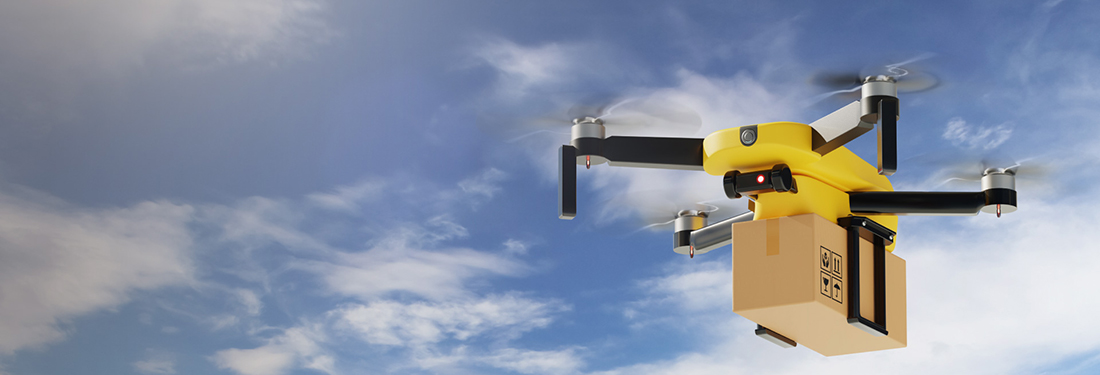Five lessons for project managers on innovation projects

Open Skies Cornwall is a live research and development project funded by Innovate UK, testing the potential for drones to deliver cargo over longer distances. We’re not talking people’s next day deliveries of USB cables and shampoo. It’s for services like the NHS — transporting bloods from around Cornwall and the Isles of Scilly to Truro’s Royal Cornwall hospital — and Royal Mail, delivering packages to hard-to-reach places, such as the Scillies when the sea fog rolls in.
Daniel Pollitt is a project manager with Mott MacDonald, working closely, via secondment, with project lead DronePrep who are co-ordinating the Open Skies consortium. Their role is to assist the 10 partners (DronePrep, Neuron, Skyports, NHS, Royal Mail, Cornwall Council, Falmouth Harbour, University of Southampton, J-HUB-MED, The Flight Corp.), in reaching innovative project milestones, amongst a host of other typical project elements.
While the social benefit of drone deliveries may be easy to grasp, it doesn’t make it any less challenging to get such a complex undertaking off the ground. Bear in mind the field is so new, the Civil Aviation Authority (CAA) are in the early stage of developing the necessary regulation.
Here are five key learnings for project managers who find themselves looking to make pioneering projects soar:
1. Be disciplined about communication
Stakeholder complexity can be a massive project management challenge. Some of the partners have lots of governance and controls, whilst at the other end of the scale, SME partners may have only two or three people. “The key is to bring the two cultures together, getting everyone to speak the same language, so everyone understands exactly who is responsible for what,” says Pollitt. One solution was to insist on regular weekly calls.
“Having that basic oversight can be a difficult thing to orchestrate with so many partners,” says Pollitt. “But by forcing ourselves to get together once a week, we’ve provided transparency to everyone. People can see how the project is progressing against the various milestones, and they get a clearer picture of what everyone else does. It also allows us to be more proactive when opportunities or problems come up.”
2. Honour your stakeholders’ needs
Everyone has competing priorities. When it’s hard to get engagement from stakeholders, it’s important to be agile about people’s availability, and make the most of their time when you have them. Big public organisations also tend to have strict requirements around how you talk about projects. “Managing PR is very tricky,” says Pollitt. “When people start talking about drone deliveries, it’s important to focus on the benefits, and helping people how it will impact them. Our project is all about the end-user benefits, but we still have to be very careful about our messaging, to make sure the partners are happy with what's going out.”
3. Know the job may be bigger than you thought
In the case of longer distance drone deliveries, the regulation is brand new, so the project management role isn’t just about analysing and implementing a traditional project plan. It’s also about adapting to the project opportunities presented by the project architect (DronePrep), consortia members and regulator to support agile pathways within the project for the possibility of future flight.
4. Create contingency plans
Make sure everyone understands the risks associated with such a new approach, especially when operating in a field fed by ground-breaking concepts. “In tech R&D projects, working with these very inspired small companies who have lots of great ideas, it can be tempting to jump into things quickly,” says Pollitt. “In theory, they could work, so you’re keen to rewrite the rulebook and do things completely differently. You need to understand the risks and put contingencies in place. We're still agile. We can still react to new developments. But project management gives us a level of control and discipline that helps a lot.”
5. Don’t under-estimate your toolkit
The technology and processes may be brand new, but you can probably call on a wealth of existing knowledge to help navigate the challenges. Pollitt explains how he worked in rail infrastructure prior to shifting to aviation. “I’ve been able to apply all the project management skills I developed as the railway project manager in this new environment,” he says. “It has shown me that project management skills are transferable, and that it’s just about being confident in your abilities as a project manager. That has probably been my biggest learning.”
You may also be interested in:
Why we need to start afresh and rediscover innovation


2 comments
Log in to post a comment, or create an account if you don't have one already.
EXCELLENT. CONGRATULATIONS DAVID
Your article Dave W. raises some excellent points for consideration. One question that comes to mind is whether a substantial battery would be necessary for the drone project. When we consider this, it becomes apparent that a larger battery equates to increased weight, which in turn reduces carrying capacity. This is a significant constraint for long-range electric vehicles (EVs), as beyond a certain point, the weight of the battery makes it highly inefficient to transport such 'dead weight' and still achieve the desired mileage. This issue is even more pronounced with drones. Currently personal play, drones have a maximum flight time of around 20 minutes, which can be extended slightly by removing cameras and other non-essential items. However, flight time is greatly affected by wind and other weather conditions, not to mention the risk of collision with obstacles like trees buildings etc. Considering these factors, it seems that drone delivery services may not be viable unless they operate very close to the distribution centers housing the goods. In such cases, it would likely be more effective and efficient to consolidate 30 or 40 deliveries for the area and transport them via ground vehicle. This approach would save on project costs, charging time, and numerous return trips. There are also several risks associated with drone delivery that come to mind but are not detailed here. Is there an aspect of the drone project that I'm overlooking or perhaps misunderstanding that makes the business case viable? I would love to know those points as my mind just keeps thinking not a viable project to archive the end goals of quick, cheep and efferent delivery. That said I will take the 5 points you have highlighted and apply to my own projects. From that aspect this article is very good.